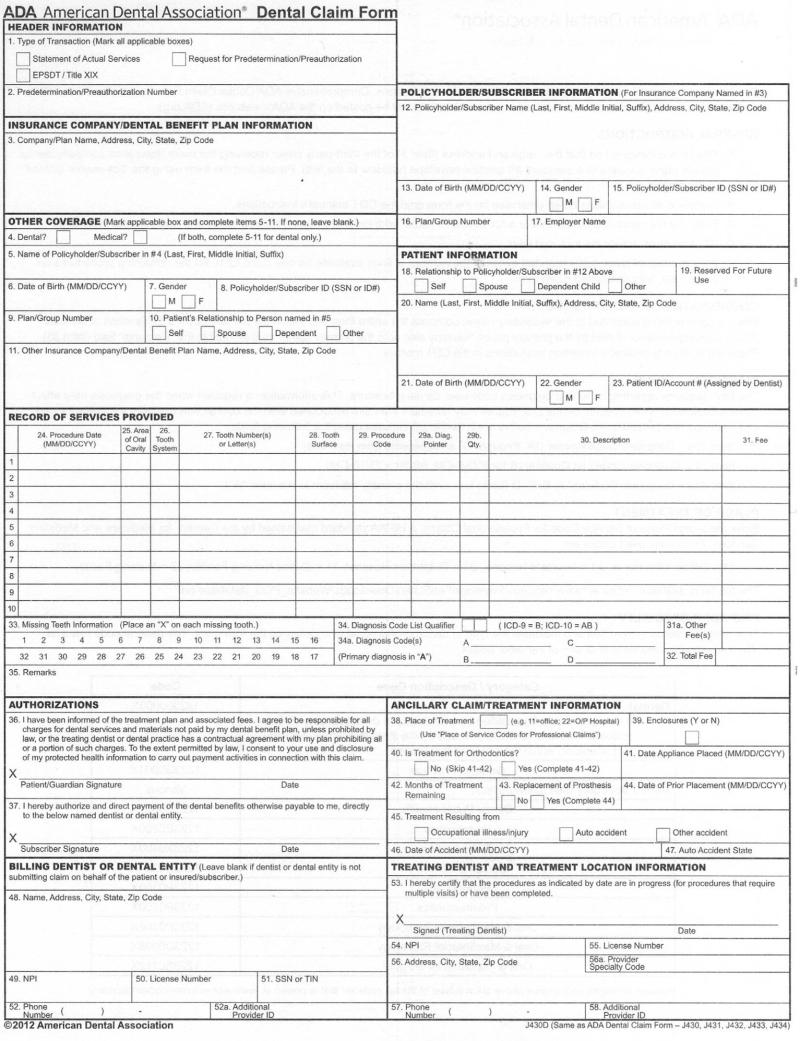Who is responsible for the ADA Dental Claim Form?
The responsibility for handling the ADA Dental Claim Form can vary depending on the specific circumstances and the parties involved in a dental insurance claim. In general, the primary responsibilities are as follows:
Dentist or Dental Provider: The dentist or dental provider is responsible for completing the ADA Dental Claim Form when submitting a dental insurance claim on behalf of a patient. They must accurately document the services provided, including procedure codes, tooth numbers, and any applicable diagnostic information.
Patient: The patient plays a role in the claims process by providing accurate personal and insurance information to the dental provider. This includes details about their dental insurance coverage, such as the insurance company, policy number, and group number. Patients should also verify their coverage and benefits with their insurance provider.
Dental Office Staff: Dental office staff, such as dental receptionists or billing personnel, often assist in the completion of the ADA Dental Claim Form. They may help patients fill out the patient information section of the form and ensure that all necessary details are included.
Insurance Company: The insurance company or dental insurance carrier is responsible for processing and adjudicating the dental claim. This involves reviewing the ADA Dental Claim Form, verifying the provided information, and determining the coverage and benefits applicable to the services rendered. The insurance company will then issue an Explanation of Benefits (EOB) to the patient and dental provider, detailing the payment or denial of the claim.
Third-Party Administrators (TPAs): Some dental insurance plans are administered by third-party administrators. In such cases, the TPA may handle the processing of dental claims and the communication of claim-related information to the patient and dental provider.
It's important for both the dental provider and the patient to work together to ensure that the ADA Dental Claim Form is accurately completed and submitted in a timely manner. Any discrepancies or issues with the claim may need to be addressed through communication between the dental office and the insurance company. Patients should also be aware of their insurance plan's coverage limitations and be prepared to cover any out-of-pocket costs.
Ultimately, the dental provider is responsible for properly documenting the services provided and submitting the claim, while the insurance company is responsible for assessing the claim and providing reimbursement according to the patient's dental insurance policy. Communication and collaboration between all parties involved can help facilitate a smooth and efficient claims process.
Responsibility for the ADA Dental Claim Form: Oversight and Usage
The ADA Dental Claim Form is a standardized form used to submit dental claims to insurance companies. The form is developed and maintained by the American Dental Association (ADA), which is the leading professional organization for dentists in the United States. The ADA is responsible for overseeing the use of the form, ensuring that it is accurate and up-to-date. The ADA also provides training and resources to dentists and dental staff on how to use the form correctly.
ADA Dental Claim Form and its Administrative Stewardship
The ADA Dental Claim Form is a complex document that requires careful administration. The ADA has a team of experts who are responsible for managing the form, including:
Updating the form: As dental procedures and insurance coverage change, the ADA must update the form to reflect these changes.
Resolving disputes: If there are disputes about how to use the form, the ADA can provide guidance and resolution.
Educating dental professionals: The ADA provides training and resources to dentists and dental staff on how to use the form correctly.
ADA's Role in Dental Claim Form Standardization and Management
The ADA plays a vital role in standardizing and managing the ADA Dental Claim Form. This helps to ensure that:
Dental claims are processed accurately and efficiently.
Dentists and insurance companies have a common language for communicating about dental claims.
Patients are able to track their dental claims and understand their benefits.
The ADA's work on the ADA Dental Claim Form is just one of the many ways that the organization helps to improve the quality of dental care in the United States.
Conclusion
The ADA Dental Claim Form is an important tool for dentists and insurance companies. The ADA's careful oversight of the form helps to ensure that it is used accurately and efficiently, which benefits both patients and providers.












